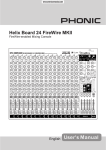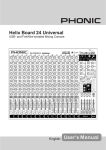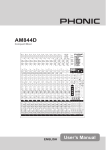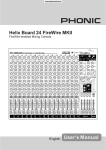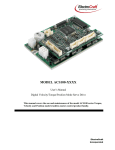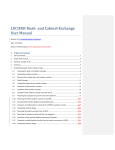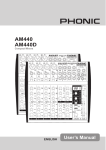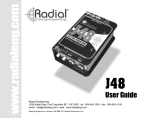Download sonic station 22/32
Transcript
Sonic Station 22 Sonic Station 32 Mixing Console Sonic Station 22 English IMPORTANT SAFETY INSTRUCTIONS The apparatus shall not be exposed to dripping or splashing and that no objects filled with liquids, such as vases, shall be placed on the apparatus. The MAINS plug is used as the disconnect device, the disconnect device shall remain readily operable. Warning: the user shall not place this apparatus in the confined area during the operation so that the mains switch can be easily accessible. 1. Read these instructions before operating this apparatus. 2. Keep these instructions for future reference. 3. Heed all warnings to ensure safe operation. 4. Follow all instructions provided in this document. 5. Do not use this apparatus near water or in locations where condensation may occur. 6. Clean only with dry cloth. Do not use aerosol or liquid cleaners. Unplug this apparatus before cleaning. 7. Do not block any of the ventilation openings. Install in accordance with the manufacturer’s instructions. 8. Do not install near any heat sources such as radiators, heat registers, stoves, or other apparatus (including amplifiers) that produce heat. 9. Do not defeat the safety purpose of the polarized or grounding-type plug. A polarized plug has two blades with one wider than the other. A grounding type plug has two blades and a third grounding prong. The wide blade or the third prong is provided for your safety. If the provided plug does not fit into your outlet, consult an electrician for replacement of the obsolete outlet. 10. Protect the power cord from being walked on or pinched particularly at plug, convenience receptacles, and the point where they exit from the apparatus. 11. Only use attachments/accessories specified by the manufacturer. 12. Use only with a cart, stand, tripod, bracket, or table specified by the manufacturer, or sold with the apparatus. When a cart is used, use caution when moving the cart/apparatus combination to avoid injury from tipover. 13. Unplug this apparatus during lighting storms or when unused for long periods of time. 14. Refer all servicing to qualified service personnel. Servicing is required when the apparatus has been damaged in any way, such as power-supply cord or plug is damaged, liquid has been spilled or objects have fallen into the apparatus, the apparatus has been exposed to rain or moisture, does not operate normally, or has been dropped. CAUTION RISK OF ELECTRIC SHOCK DO NOT OPEN CAUTION: TO REDUCE THE RISK OF ELECTRIC SHOCK, DO NOT REMOVE COVER (OR BACK) NO USER SERVICEABLE PARTS INSIDE REFER SERVICING TO QUALIFIED PERSONNEL The lightning flash with arrowhead symbol, within an equilateral triangle, is intended to alert the user to the presence of uninsulated “dangerous voltage” within the product’s enclosure that may be of sufficient magnitude to constitute a risk of electric shock to persons. The exclamation point within an equilateral triangle is intended to alert the user to the presence of important operating and maintenance (servicing) instructions in the literature accompanying the appliance. WARNING: To reduce the risk of fire or electric shock, do not expose this apparatus to rain or moisture. CAUTION: Use of controls or adjustments or performance of procedures other than those specified may result in hazardous radiation exposure. SONIC STATION 22/32 Mixing Console TABLE OF CONTENTS INTRODUCTION..............................................................................................................................4 FEATURES.......................................................................................................................................4 BASIC SETUP...................................................................................................................................5 Getting Started.............................................................................................................................5 Channel Setup.............................................................................................................................5 MAKING CONNECTIONS................................................................................................................6 Rear Panel...................................................................................................................................6 Main Mixing Panel........................................................................................................................7 CONTROLS AND SETTINGS..........................................................................................................8 Rear Panel...................................................................................................................................8 Channel Controls.........................................................................................................................8 Digital Effect Engine.....................................................................................................................9 MASTER SECTION........................................................................................................................11 Stereo AUX Returns....................................................................................................................11 AUX/Group 1 to 4 Controls.........................................................................................................11 Master Controls and Indicators..................................................................................................12 DIGITAL EFFECT TABLE................................................................................................................14 APPLICATION................................................................................................................................15 SPECIFICATIONS..........................................................................................................................16 DIMENSIONS.................................................................................................................................18 BLOCK DIAGRAM..........................................................................................................................19 Phonic reserves the right to improve or alter any information supplied within this document without prior notice. V1.0 9/22, 2005 INTRODUCTION Thank you for choosing one of Phonic’s many quality compact mixers. The Sonic Station 22 and 32 mixing console - designed by the talented engineers that have created a variety of mixers fantastic in style and performance in the past - displays similar proficiency that previous Phonic products have shown; with more than a few refinements, of course. The Sonic Station 22 and 32 feature full gain ranges, amazingly low distortion levels, and incredibly wide dynamic ranges just showing the dominance these small machines will have in the mixing World. We know how eager you are to get started - wanting to get the mixer out and hook it all up is probably your number one priority right now - but before you do, we strongly urge you to take a look through this manual. Inside, you will find important facts and figures on the set up, use and applications of your brand new mixer. If you do happen to be one of the many people who flatly refuse to read user manuals, then we just urge you to at least glance at the Instant Setup section. After glancing at or reading through the manual (we applaud you if you do read the entire manual), please store it in a place that is easy for you to find, because chances are there is something you missed the first time around. 4 FEATURES 22/32 Mic/Line channels with inserts on Sonic Station 22/32 Mic preamps included on 2 stereo channels with individual mic and line gain controls Dual High Definition Algorithm 32/40-bit digital multi-effect processors with 16 programs plus one main parameter control, effect 2 with tap control and foot switch jacks Group/Aux and Main/CTRL RM swap for monitor console application Talkback microphone built-in 3-band EQ with swept mid-range on mono channel 75 Hz low-cut filter on each channel Six AUX send mixing bus, two pair with pre/post switch Four stereo AUX returns, each with aux send 1-4 volume controls Pad/Line in on mono channels to handle difficult signals +48V phantom power group switches Four true subgroups with main L and R routing switches, pan controls and inserts Direct outputs with pre/post switches for multitrack recording Each input and outputs with solo monitoring feature Mono out with variable low pass filter from 60 Hz to 160 Hz for subwoofer Rec out with trim control for record level matching 7 12-segment level meters for main, mono and group/aux On, Peak/Solo and Signal indicators on each input channel 12V gooseneck lamp socket for working on dark place Sonic Station 22/32 BASIC SETUP Getting Started 1. Ensure all power is turned off on the Sonic Station mixer. To totally ensure this, the AC cable should not be connected to the unit. 2. All faders and level controls should be set at the lowest level and all channels switched off to ensure no sound is inadvertently sent through the outputs when the device is switched on. All levels should be altered to acceptable degrees after the device is turned on. 3. Plug all necessary instruments and equipment into the device's various inputs as required. This may include line signal devices, as well as microphones and/or guitars, keyboards, etc. 4. Plug any necessary equipment into the device's various outputs. This could include Amplifiers, active speakers or monitors, signal processors, and/ or recording devices. 5. Plug the supplied power adaptor into the power inlet on the back of the device ensuring the local voltage level is identical to that required on your external power supply. 6. Plug the supplied adapter into a power outlet of a suitable voltage. 7. Turn the power switch on. Channel Setup 1. To ensure the correct audio levels of each input channel is selected, every channel should first be switched off and all faders set to 0. Also, all EQ controls should be set in the center, and all AUX sends down. 2. Choose the channel that you wish to set the level of and ensure that channel has a signal sent to it similar to the signal that will be sent when in common use. For example, if the channel is using a microphone, then you should speak or sing at the same level the performer normally would during a performance. If a guitar is plugged into that channel, then the guitar should also be used as it normally would be. 3. Press the Solo button of the channel, and ensure the Pre / Post button under the CTRL RM level control on the master section is released, allowing you to see the audio properties in the level meter. 4. Turn the gain of the selected channel up to a level that ensures the audio level sits around 0 dB, as indicated by the level meter. Be careful not to let the audio reach +7 dB. 5. This channel is now ready to be used; you can stop making the audio signal. 6. To activate the channel, release the Solo button and engage the channel’s on button and press the 1/2, 3/4, mono or L/R routing buttons, allowing the signal to be sent to the corresponding destinations. 7. You should now select the next channel to set and go back to follow steps 1 through 6. Sonic Station 22/32 5 MAKING CONNECTIONS Rear Panel 1. XLR Jacks These jacks accept XLR inputs for balanced signals. They can be used in conjunction with microphones such as professional condenser, dynamic or ribbon microphones - with standard XLR male connectors. With low noise preamplifiers, these inputs serve for crystal clear sound replication. NB. When using an unbalanced microphone, please ensure phantom power is switched off. However, when using condenser microphones the phantom power should be activated. 2. Line In Jacks These balanced inputs accept 1/4” TRS and 1/4” TS line inputs for the addition of various music instruments – such as keyboards, drum machines, electric guitars, as well as a variety of other electric instruments. 3. Insert Jacks The primary use for these TRS phone jacks is for the addition of external devices, such as dynamic processors or equalizers, to the corresponding mono input channel. This will require a Y cord that can send and receive signals of the mixer to and from an external processor. The tip of the TRS jack will send the signal from the input channel, and the ring will return the signal back to the mixer (the sleeve is the grounding). 4. Direct Outputs and PRE button These connections are for the direct output of the unbalanced signals received by mono channels. They are typically post-fader, post-EQ, post-LCF, post-mute, however with the included “PRE” button they easily become pre-fader and pre-EQ (as well as post-gain, post-insert and post-LCF). They are most commonly used to connect Multi-track recorders. 5. Stereo Channels The two stereo channels on the Sonic Station (channels 19/20 and 21/22 on the Sonic Station 22; channels 29/30 and 31/32 on the Sonic Station 32) include XLR Mic inputs and 1/4” TRS phone jacks, as well as stereo RCA inputs. There can be used in conjunction with various stereo devices, such as synthesizers and keyboards. Also, by connecting a mono signal to the left phone jack, the Sonic Station automatically doubles the signal over to the right channel. This is known as Jack Normalizing. 6. Auxiliary (AUX) Returns The 1/4” TRS AUX Return inputs are for the return of audio to the Sonic Station mixer, processed by an external signal processor. If really needed, they can also be used as additional stereo inputs. The feed from these inputs can be adjusted using the AUX Return controls on the face of the mixer. When connecting a monaural device to the AUX Return inputs, simply plug a 1/4” phone jack into the left (mono) input, and the signal will appear in the right as well. 7. Auxiliary (AUX) Sends These balanced 1/4” TRS phone jacks are the final output of linelevel signal fed from the corresponding auxiliary send mixing buses, and are best suited for use with external effect processors or stage monitors. Feeding the output from the Auxiliary outs to an equalizer and amplifier, and then to a floor monitor speaker allows artists to monitor their own instruments or vocals whilst performing. 8. Foot Switch Jacks These ports are for the inclusion of a foot switch (non-latchable), used to remotely adjust properties of the built-in Digital Effect processor, to the mixer. The right jack is used to turn the device on and off, where the left jack is used for adjusting tap delay properties. 6 Sonic Station 22/32 9. Group Outs These balanced 1/4” TRS phone jacks output the final feed from the Group 1, 2, 3 and 4 Faders on the main panel of the mixer. These outputs can be used to feed multi-track records, as well as an amplifier and speakers to be used along with the Main Speakers. 10. Group/Aux Insert These TRS phone jacks are for the addition of external devices, such as equalizers or various other processors, to the corresponding Group or AUX output (depending on the SWAP settings). This will require a Y cord that can send and receive signals of the mixer to and from an external processor. The tip of the TRS jack will send the signal from the input channel, and the ring will return the signal back to the mixer (the sleeve is the grounding). 11. Mono / Subwoofer Output This XLR output feeds a monaural signal of the Main L-R signals combined, as adjusted by the accompanying level control (the signal of which is taken from individual channels and/or the main mix). This is ideal for use with a mono sound system, or for the addition of a subwoofer to your set of speakers, adding more punch to low frequency sounds (ensure you activate the low pass filter when using a subwoofer). Also featured is an Insert point, allowing external devices, such as a compressor, to be used to alter the mono signal before it is fed through the outputs. 12. Main Outputs These outputs will output the final stereo line level signal sent from the main mixing bus. The primary purpose of the two male XLR jacks is to send the main output to external devices, which may include power amplifiers (and in-turn, a pair of speakers), other mixers, as well as a wide range of other possible signal processors (equalizers, crossovers, etcetera). Also featured on each output is an Insert point, allowing external devices, such as a compressor, to be used to alter the signal before it is fed through the outputs. Sonic Station 22/32 13. 2T RTN The first of these inputs accommodates RCA cables from such devices as tape and CD players. 14. Record Outputs with Trim Control As with the 2T Return ports, these outputs will accommodate RCA cables, able to be fed to a variety of recording devices. The Record Out also features a convenient trim control (located on the front panel), allowing for simple level matching while recording. 15. CTRL RM (Control Room) Output These two 1/4” Phone Jack outputs feed the signal altered by the Control Room level control on the face of the mixer. This output has extensive use, as it can be used to feed the signal from the mixer to an active monitor, for the monitoring of the audio signal from within a booth, among many other possible uses. 16. Power Supply Connector This port is for the addition of a power cable and supply, allowing power to be supplied to the mixer. Plug one end of the supply to the Sonic Station mixer, and then the supply’s AC cable into a power outlet of a suitable voltage (check local voltage levels before connecting). Please use the power adaptor that is included with this mixer only. 17. 12V Lamp This BNC socket allows you to attach a 12 Volt gooseneck lamp, allowing better visibility in areas with poor light. The Sonic Station 22 features one of these sockets, whereas the Sonic Station 32 features two. Main Mixing Panel 18. Phones Output This output port is best suited for use with headphones, allowing monitoring of the mix. The audio level of this output is controlled using the Phones control on the front panel’s master section. 7 CONTROLS AND SETTINGS Rear Panel 19. Power Switch This switch is used to turn the mixer on and off. Ensure you turn all level controls down before activating. Activation of the Sonic Station mixer is accompanied by a blue LED lighting up in the meter section. Channel Controls 20. PAD Button These buttons, located on all input channels, attenuate the input signal of the Mic inputs by 20 dB, and allow line inputs to be fed to the channel. This gives a greater dynamic range to the input, allowing inputs with higher-level signals to be used without the possibility of clipping. NB. When this button is not pushed in, line inputs are not received by the corresponding input channel. When activated, mic inputs are attenuated 20 dB, however are cut off if a line input is inserted. Stereo channels (19/20 and 21/22 on the Sonic Station 22; 29/30 and 31/32 on the Sonic Station 32) differ slightly, in that they feature a single control for adjusting Middle Frequencies only, with a set frequency of 2.5 kHz. 25. Low Frequency Control This control is used to give a shelving boost or cut of ±15 dB to low frequency (80 Hz) sounds. This will adjust the amount of bass included in the audio of the channel, and bring more warmth and punch to drums and bass guitars. 21. Gain Control This controls the sensitivity of the input signal of the Line/Microphone input of mono channels. The gain should be adjusted to a level that allows the maximum use of the audio, while still maintaining the quality of the feed. This can be accomplished by adjusting it to a level that will allow the peak indicator occasionally illuminate or slightly lower than this. Please refer to the channel set up section. 26. AUX Controls These four AUX controls alters the signal level that is being sent to the auxiliary 1 to 4 mixing buses, the signal of which is suitable for connecting stage monitors, allowing artists to listen to the music that is being played, or to fed to an external effect processors. AUX 1/2 and AUX 3/4 each feature a Pre/Post button, which alternates the feed to the AUX mixing bus between a post and pre-fader feed. 22. Low Cut Filter (75 Hz) This button, located on all channels, will activate a high-pass filter that reduces all frequencies below 75 Hz at 18 dB per Octave, helping to remove any unwanted ground noise or stage rumble. 27. EFX 1 and 2 / AUX 5 and 6 Controls These two controls act as EFX send for the two internal effect processors. They allow users to adjust the post fader signal of the corresponding input channel to be sent to the EFX 1 and 2 mixing buses. The signal is also sent to the AUX 5 and 6 mixing buses, allowing the signal to be output via the AUX 5 and 6 Sends. 23. High Frequency Control This control is used to give a shelving boost or cut of ±15 dB to high frequency (12 kHz) sounds. This will adjust the amount of treble included in the audio of the channel, adding strength and crispness to sounds such as guitars, cymbals, and synthesizers. 24. Middle Frequency Control This control is used to provide a peaking style of boost and cut to the level of middle frequency sounds at a range of ±15 dB. The Sonic Station mixer also provides a sweep control, allowing you to select a center frequency between 100 Hz and 8 kHz. Changing middle frequencies of an audio 8 feed can be rather difficult when used in a professional audio mix, as it is usually more desirable to cut middle frequency sounds rather than boost them, soothing overly harsh vocal and instrument sounds in the audio. 28. Pan/Balance Controls This alternates the degree or level of audio that the left and right side of the main mix should receive. On mono channels, the PAN control will adjust the level that the left and right should receive (pan), where as on a stereo channel, adjusting the BAL control will attenuate the left or right audio signals accordingly (balance). Sonic Station 22/32 29. On Button and Indicator This turns the corresponding channel on, allowing the user to use the feed from the channel’s inputs to supply the MAIN L/R, MONO, GROUP 1/2, GROUP 3/4, AUX and EFX buses (as specified by the user, of course). The indicator beneath this button will be illuminated when the channel is active. 30. Sig Indicator This LED indicator shows when the input level (post EQ) reaches -20 dBu, basically showing when a signal is received by the corresponding channel. 31. 1-2, 3-4, Mono and L-R Buttons These handy buttons allow you to decide the audio path of the corresponding channel. Pushing the “1/2” or “3/4” buttons allows the signal to be sent to the Group 1/2 or 3/4 mixes respectively, where the “mono” or “L-R” allow it to be sent to the Mono or Main L/R mixes. Digital Effect Engines 35. AUX 5 and 6 (EFX 1 and 2) Controls and Solo Button These two rotary controls allow users to adjust the final output level of the AUX 5 and 6 signals, sent to the AUX 5 and 6 send outputs, as well as Digital Effect Processors 1 and 2. When the corresponding solo buttons are pushed, the AUX 5 and 6 (EFX 1 and 2) signals are affectively sent to the Control Room / Phones mixing bus, allowing the signal to be monitored. 36. Digital Effect Display This panel displays the titles of different effects that can be added to the EFX 1 and 2 signals. When you select the effect, the LED beneath the effect name will illuminate, and the alteration be applied automatically. For a list of available effects, please observe the Digital Effect Table. 32. Peak Indicator This LED indicator will illuminate when the channel hits high peaks, 6 dB before overload occurs. It is best to adjust the channel level control so as to allow the PEAK indicator to light up on regular intervals only. This will ensure a greater dynamic range of audio. This indicator also doubles as a Solo indicator, when the SOLO button is engaged. 33. Solo Button and Peak Indicator The Solo button is pushed to allow the signal of the corresponding channel to be sent to the Control Room / Phones mixing bus (pre or post fader, depending on the properties selected by the pre / post button, located below the solo level control), for use with either headphones or studio monitors. This button also allows for easier isolation of individual channel signals, ensuring setting of the input gain or tracking of audio by sound engineers is made simpler. The indicator above the Solo button illuminates whenever the Solo button is activated, however also doubles as a Peak Indicator, illuminating when the signal reaches high peaks. 34. Channel Level Control (Fader) This 60 mm fader will alter the signal level that is sent from the corresponding channel to the appropriate destinations, as decided by the 1-2, 3-4, Mono and L-R buttons. Sonic Station 22/32 9 37. Program Control This control is used to scroll through the various effects shown on the Digital Effect Display. Turning the control will automatically change the effect and apply it to the mix. To see the list of available programs, please check the Digital Effect Table. 38. Parameter Control This will adjust the one main parameter of the digital effect program that is applied to the audio feed. Please refer to the Digital Effects Table for more information on Effect parameters. NB. The digital effect engine has a “memory” function, which allows you to adjust the parameters of a program, then, if you change the parameters of another program and return to the original one, your parameter setting will be kept until the Parameter Control is turned once again, at which time it will be altered according to the control. 39. AUX 1 to 4 Controls These four AUX controls allows users to adjust the signal level that is being sent from the EFX 1 and 2 mixes to the auxiliary 1 to 4 mixing buses, the signal of which is suitable for connecting stage monitors, allowing artists or engineers to listen to the music that is being played. This is called “Effect to Monitor”. 40. Tap Delay Button and Indicator For EFX Processor 2 only, when the tap delay program is selected, this button is used to determine the delay time. By pushing the button several times, the effect engine interprets the time between last two pushes and remembers this as the delay time until the button is pushed again. When the tap delay effect is selected, the corresponding LED will flash at the intervals selected. 10 41. Effect On Button and Indicator This button is pushed to turn the corresponding effect panel on or off. When the effect processor is turned on, the corresponding LED illuminates. 42. Sig Indicator This LED indicator shows when the input level reaches at least -20 dBu, basically showing when a signal is received by the corresponding channel. 43. 1-2, 3-4, Mono and L-R Buttons These handy buttons allow you to decide the audio path of the corresponding effect channel. Pushing the “1/2” or “3/4” buttons allows the processed signal to be sent to the Group 1/2 or 3/4 mixes respectively, where the “mono” or “L-R” allows it to be sent to the Mono or Main L/R mixes. 44. Solo and Peak Button The Solo button is pushed to allow the signal of the EFX 1 or 2 channels to be sent to the Control Room / Phones mixing bus, for use with either headphones or studio monitors. The indicator above the Solo button illuminates when activated, however also doubles as a Peak Indicator, illuminating when the effect processor overloads and has the potential to cause distortion. When the peak LED is on, turn the AUX 5 (or AUX 6) level control to a level that stops the peak LED from illuminating. 45. Level Control (Fader) This 60 mm fader will alter the signal level that is sent from the EFX 1 or 2 channels to the appropriate destinations, selected by the 1-2, 3-4, mono and L-R buttons. Sonic Station 22/32 Master Section AUX / Group 1 to 4 Controls Stereo AUX Returns 51. AUX Send 1 to 4 Master Controls These rotary controls adjust the final level of the AUX 1, 2, 3 and 4 signals (as taken from the AUX level controls 1 to 4 on each channel strip), the audio of which is sent to the corresponding AUX sends. If the GP/AUX SWAP button is pushed in, however, they perform the identical task, however for the Group 1, 2, 3 and 4 signals instead. 46. AUX 1 to 4 Controls These controls adjust the pre-fader level of the signal from the AUX Return controls to the corresponding AUX send mixing buses for effect-tomonitor sends. 47. Balance Control The Balance control allows users to adjust the degree or level of audio that the left and right side of the main mix should receive. Turning the control to the left attenuates the right AUX return signal, whereas turning it to the right attenuates the left signal. 48. Level Control These rotary controls will alter the signal level that is sent from the AUX Return 1 to 4 mixing buses to the appropriate destinations, as selected by the L/R / 1/2 or L/R / 3/4 buttons. 49. L/R - 1/2 and L/R – 3/4 Button These buttons, when pushed in, send the corresponding Stereo AUX Return signal to the Group 1 and 2 or Group 3 and 4 mixing buses. The L/R / 1/2 and L/R / 3/4 buttons decide the final destination of the AUX Return signals. When released, the corresponding signals are sent to the Main L-R mixing bus. 50. Solo Button When the Solo button is pushed the signal of the corresponding AUX Return channel is sent to the Control Room / Phones mixing bus, for use with either headphones or studio monitors. 52. Solo Button When the Solo button is pushed the signal of the corresponding AUX send is sent to the Solo and Control Room / Phones mixing bus, for use with either headphones or studio monitors. 53. GP / AUX SWAP This button (located on each AUX / GROUP control strip) allows users to swap the AUX and GROUP level controls and solo buttons. When pushed in, the AUX 1 rotary control is then used as the Group 1 control and the Group 1 60mm fader becomes the AUX 1 control. NB. This simply alternates use of the level controls and solo buttons mentioned, and in no way changes the destination of any channel’s signal. 54. Main L/R Button This button allows users to send the signal from the corresponding Group channel to the Main L/R mixing bus. 55. Group Pan Used in conjunction with the L/R button, turning this control to the left or the right allows users to adjust the amount of the Group signal the left and right channels of the main mix should receive. 56. Solo Button When the Solo button is pushed the signal of the corresponding Group is sent to the Solo and Control Room / Phones mixing bus, for use with either headphones or studio monitors. Sonic Station 22/32 11 57. Group 1 to 4 Master Controls These 60mm faders adjust the final level of the Group 1, 2, 3 and 4 signals (as taken from each channel strip), the audio of which is sent to the corresponding Group output. If the GP/AUX SWAP button is pushed in, however, they perform the identical task, however for the AUX 1, 2, 3 and 4 signals instead. Master Controls Indicators and 58. Phantom Power Buttons When one or more of these buttons is pushed in, +48V of Phantom Power for the corresponding microphone inputs is activated, allowing condenser microphones (well, the ones that need DC power, yet don’t use batteries) to be used on these channels. There are four buttons in total, each of which will activate Group Phantom Power for the channels indicated. Activating Phantom Power will be accompanied by an illuminated LED above the button. Before turning Phantom Power on, turn all level controls to a minimum to avoid the possibility of a ghastly popping sound from the speakers. NB. Phantom Power should be used in conjunction with balanced microphones. When Phantom Power is engaged, single ended (unbalanced) microphones and instruments should not be used on the Mic inputs. Phantom Power will not cause damage to most dynamic microphones, however if unsure, the microphone’s user manual should be consulted. 60. Solo Indicator When the Solo indicator, located beside the Main LR level meter, is illuminated, one or more Solo button has been pushed. In this case, the Main Level meter will display properties of the Solo signal, which is helpful in the setting of channel properties. If the Solo indicator illuminates green, this means the Solo feed is a pre-fader signal; if the solo indicator illuminates red, the feed is post-fader. 61. Power Indicator The Power Indicator will light up when the power of the mixer is on; in case you weren’t too sure. 62. Record Out Control This control allows users to adjust the level of the pre-fader Main L-R signal that is sent to the Record Output on the rear of the Sonic Station. This is helpful in matching output levels with external recording devices. 63. 2T Return Controls Turning the 2T Return level control adjusts the signal level of the feed from the 2T Return inputs. The "to Main" and "to CTRL RM" buttons that accompany this control allow users to send the 2T return signal to the Main L-R and Control Room mixing buses. When the "to Main" button is pressed, the Main L-R mix signal is not sent to the Rec Out, as to avoid producing a feedback loop when recorded signals are fed back into the 2T return. 59. Level Meter These 12 segment level meters give an accurate indication the level of the Group 1 - 4 (or AUX), Mono or Main left and right audio signals. The 0 dB indicator illuminates is approximately equal to an output level of +4 dBu (balanced), and the PEAK indicator illuminates about 1.5 dB before the signal is dynamically clipped. To make the maximum use of audio, set the various level controls so that it sits steadily around 0 dB to make full use of audio, while still maintaining fantastic clarity. If any Solo buttons are activated on input channels, or in the master or group/aux sections, the Main L/R Level Meter will display the Solo signal’s properties. 12 Sonic Station 22/32 64. Talkback Mic and Button Talking into the built-in talkback microphone of the Sonic Station, while pushing down the Talkback button, allows users to send their voice to any of the outputs, as selected by the Talkback destination buttons. Pressing the external mic button will replace the built-in mic signal with the external microphone. 65. Talkback Control This control adjusts the level of the Talkback mic's (either internal or external) signal, which is sent to the destinations decided by the talkback selection buttons. 70. Mix To Mono Button This button does exactly what it says. It sends the Main mix of the Sonic Station mixer to the Mono mixing bus. 71. Main L/R Faders This fader is the final level control for the Main Left and Right audio feeds, sent to the Main L and R outputs. When pushed all the way up, the Main L/R fader provides 10 dB of gain to the signal, and when set all the way down, the signal is effectively muted. 66. Talkback Destination Buttons These four buttons allow users to send the Talkback signal to their corresponding mixing buses. 67. External Talkback Mic Button and XLR jack When an external microphone is plugged into this XLR jack, the External Mic button should be pressed, allowing it to be used as the Sonic Station's talkback microphone. 68. Main / Control Room Swap Buttons These buttons allow users to swap the Main Left and Right controls with the Control Room / Phones control, effectively making the Sonic Station an ideal monitoring console. Please note, that only the volume control is swapped, the pre/post and mix to mono buttons function the same way as always. 69. Control Room / Phones Control and Pre/Post button This control is used to adjust the audio level of the Control Room and Phones feeds, for use in the monitoring and tracking of audio. The signal is then sent to the Control Room outputs on the rear of the Sonic Station mixer, as well as the Phones jack on the face of the mixer. 72. Mono Channel The 60mm faders is the final level control for the Mono mixing bus, the signal of which is sent to the Mono output on the rear of the Sonic Station mixer. The included solo button allows users to send the Mono signal to the Solo mixing bus. A Low Pass Filter has been included to cut unwanted high frequency sounds of the mono output at a rate of 12 dB per octave, for a clearer bass sound when using subwoofers. The switch turns the Low Pass Filter on and off, whereas the accompanying control adjusts the cut-off frequency between 60 and 160 Hz. The pre / post button located under the Control Room / Phones control allows users to change the signal received by the Control Room / Phones mixing bus between that of a pre-fader and that of a post-fader signal. Priority Signal High From Solo Mid From 2T Return Low Main Left and Right and Talkback Microphone Sonic Station 22/32 13 DIGITAL EFFECT TABLE Program Parameter Variable Range 1 Hall Reverb Time 0.3 – 10 sec 2 Room Reverb Time 0.3 – 3.2 sec 3 Plate Reverb Time 0.3 – 10 sec 4 Cathedral Reverb Time 0.3 – 10 sec 5 Arena Reverb Time 0.3 – 10 sec 6 Spring Reverb Time 0.3 – 10 sec 7 Opera Reverb Time 0.3 – 10 sec 8 Rev Vocal Reverb Time 0.3 – 10 sec 9 Delay 1 (One Repeat) Delay Time 0 – 800 ms Program Parameter Variable Range 10 Delay 2 (Two Repeats) Delay Time 0 – 800 ms 11 Delay 3 (Three Repeats) Delay Time 0 – 800 ms 12 Delay 4 (Four Repeats) Delay Time 0 – 800 ms 13 Chorus + Delay Delay Time & Feedback Delay Time: 0-800ms; Feedback: 30-66 14 Flange + Delay Delay Time & Feedback Delay Time: 0-800ms; Feedback: 30-66 15 Tremolo Speed 0.1 – 10 Hz 16 Panning Delay Speed 0.1 – 10 Hz Program Parameter Variable Range 10 Echo Delay Time 0 – 800 ms 11 Multi-Pong Delay Time 0 – 800 ms 12 Karaoke Delay Time & Feedback Delay Time: 160-260 ms ; Feedback: 45-65 13 Chorus + Rev DEPTH 0 – 100 14 Flange + Rev Modulation Frequency 0.05 – 4.00 Hz 15 Phaser + Rev Modulation Frequency 0.05 – 4.00 Hz 16 Tap Delay Feedback Gain 0 – 99% Effect 1 Effect 2 14 Sonic Station 22/32 APPLICATION Live Setup 8-Track Tracking 8-Track Tracking Sonic Station 22/32 15 SPECIFICATIONS SONIC STATION 22 SONIC STATION 32 Balanced Mic / Mono Line Channel 18 28 Balanced Mic/ Stereo Line Channel 2 2 Mic Preamps 20 30 Inputs Aux Return 2T Input 4 stereo 4 stereo Stereo RCA Stereo RCA 2 x XLR 2 x XLR Yes Yes 1 x XLR 1 x XLR Outputs Main L/R Stereo Main out with inserts Main Mono Main Mono out with inserts Yes Yes 18, including pre-ch EQ switch 28, including pre-ch EQ switch Rec Out with Trim Control Stereo RCA Stereo RCA CTRL RM L/R 2 x 1/4” TS 2 x 1/4” TS Phones 1 1 Channel Strips 20 30 Pad (line in) switches 20 30 Aux Sends 6 6 Direct out Pan/Balance Control Channel routing switches Indicators Volume Controls Yes Yes Group 1/2, 3/4, Main Mono, Main L/R Group 1/2, 3/4, Main Mono, Main L/R On, Signal, Peak/Solo On, Signal, Peak/Solo 60mm fader 60mm fader 6 6 Master Section Aux Send Masters Master Aux Send Solo 6 6 4, each with aux 1-4 volume control 4, each with aux 1-4 volume control Aux Return Assign to Subgroup 4 4 Effects Return to Monitor 4 4 Global PRE/POST Solo Mode Yes Yes Group 1-4/Aux 1-4 Swap buttons Yes Yes Main fader / CTRL RM volume control swap buttons Yes Yes Built-in, can be routed to Aux 1/2, 3/4, Main L/R & CTRL RM, or use external mic(with +48V phantom power) Built-in, can be routed to Aux 1/2, 3/4, Main L/R & CTRL RM, or use external mic(with +48V phantom power) Stereo Aux Returns Talkback Mic Faders 4 subgroups, Main mono, Main L/R 4 subgroups, Main mono, Main L/R Metering Number of Channels 7 7 Segments 12 12 +48V DC +48V DC 4 6 Phantom Power Supply Switches Effect Processor 1 (32/40-bit DSP 16 effects with one main parameter 16 effects with one main parameter engine) control control 16 Sonic Station 22/32 16 effects with one main parameter control, tap delay control, foot switch (effect on/off, tap) 16 effects with one main parameter control, tap delay control, foot switch (effect on/off, tap) 20Hz ~ 60KHz +0/-1 dB +0/-1 dB 20Hz ~ 100KHz +0/-3 dB +0/-3 dB <-90 dB <-90 dB Master @ unity, channel fader down -86.5 dBu -86.5 dBu Master @ unity, channel fader @ unity -84 dBu -84 dBu Effect Processor 2 engine) (32/40-bit DSP Frequency Response (Mic input to any output) Crosstalk (1KHz @ 0dBu, 20Hz to 20KHz bandwidth, channel in to main L/R outputs) Channel fader down, other channels at unity Noise (20Hz~20KHz; measured at main output, Channels 1-4 unit gain; EQ flat; all channels on main mix; channels 1/3 as far left as possible, channels 2/4 as far right as possible. Reference=+6dBu) S/N ratio, ref to +4 >90 dB >90 dB <-129.5 dBm <-129.5 dBm THD (Any output, 1KHz @ +14dBu, 20Hz to 20KHz, channel inputs) <0.005% <0.005% CMRR (1 KHz @ -60dBu, Gain at maximum) 80dB 80dB Mic Preamp Input +10dBu +10dBu All Other Input +22dBu +22dBu Unbalanced Output +22dBu +22dBu Balanced Output +28dBu +28dBu Microphone Preamp E.I.N. ohms terminated, max gain) (150 Maximum Level Impedance Mic Preamp Input 2 K ohms 2 K ohms All Other Input (except insert) 10 K ohms 10 K ohms RCA 2T Output 1.1 K ohms 1.1 K ohms Outputs 200 ohms 200 ohms 3-band, +/-15dB 3-band, +/-15dB 80Hz 80Hz Mid EQ (mono channels) 100-8k Hz, sweepable 100-8k Hz, sweepable Mid EQ (stereo channels) 2.5k Hz 2.5k Hz Hi EQ 12 kHz 12 kHz 75 Hz (-18 dB/oct) 75 Hz (-18 dB/oct) 65 watts 70 watts 100~120V AC, 220~240V AC, 50/60Hz 100~120V AC, 220~240V AC, 50/60Hz Equalization Low EQ Low cut filter Power consumption Power Requirement (depends on region) Net Weight (without adapter) Dimensions (WxHxD) Sonic Station 22/32 15.5 kg (34.14 lbs) 18 kg (39.65 lbs) 859x102.79x547.42 mm (33.8”x4.05”x21.6”) 1155.5x102.79x547.42 mm (45.5”x4.05”x21.6”) 17 DIMENSIONS Sonic Station 22 Dimensions 859.00/33.8 543.49/21.4 547.42/21.6 102.79/4.05 98.90/3.9 Sonic Station 32 Dimensions 1155.50/45.5 543.49/21.4 547.42/21.6 102.79/4.05 98.90/3.9 measurements are shown in mm / inches 18 Sonic Station 22/32 BLOCK DIAGRAM Sonic Station 22/32 19 TO PURCHASE ADDITIONAL PHONIC GEAR AND ACCESSORIES To purchase Phonic gear and optional accessories, contact any authorized Phonic distributor. For a list of Phonic distributors please visit our website at www.phonic.com and click on Get Gear. You may also contact Phonic directly and we will assist you in locating a distributor near you. SERVICE AND REPAIR Phonic has over 100 service centers worldwide. For replacement parts, service and repairs please contact the Phonic distributor in your country. Phonic does not release service manuals to consumers, and advice users to not attempt any self repairs, as doing so voids all warranties. You can locate a dealer near you at www.phonic.com. WARRANTY INFORMATION Phonic stands behind every product we make with a no-hassles warranty. Warranty coverage may be extended, depending on your region. Phonic Corporation warrants this product for a minimum of one year from the original date of purchase against defects in material and workmanship under use as instructed by the user’s manual. Phonic, at its option, shall repair or replace the defective unit covered by this warranty. Please retain the dated sales receipt as evidence of the date of purchase. You will need it for any warranty service. No returns or repairs will be accepted without a proper RMA number (return merchandise authorization). In order to keep this warranty in effect, the product must have been handled and used as prescribed in the instructions accompanying this warranty. Any tempering of the product or attempts of self repair voids all warranty. This warranty does not cover any damage due to accident, misuse, abuse, or negligence. This warranty is valid only if the product was purchased new from an authorized Phonic dealer/distributor. For complete warranty policy information, please visit http://www.phonic.com. CUSTOMER SERVICE AND TECHNICAL SUPPORT We encourage you to visit our online help at http://www.phonic.com/help/. There you can find answers to frequently asked questions, tech tips, driver downloads, returns instruction and other helpful information. We make every effort to answer your questions within one business day. Phonic America Corporation 6103 Johns Road, #7 Tampa, FL 33634 (813) 890-8872 [email protected] http://www.phonic.com























